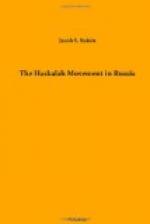[Footnote 2: Urussov, Memoirs of a Russian Governor (Engl. transl., New York, 1908), pp. 70, 90-91. “Out of 266 students admitted to the Kharkov University in 1901, only 8 were Jews, though at least 12 had ’finished the gymnasium,’ not only with the ‘highest possible’ marks, but with gold medals. At the Technological Institute of the same city, 7 were Jews in a total of 240, though 12 applying for admission had received the ‘highest possible’ marks. At the Kiev University, of 580 new students, 32, all of them medallists, were Jews. How many applied for admission, the daily and weekly press, from which these figures are taken, did not report.”]
[Footnote 3: Ner ha-Ma’arabi, vii, 27.]
[Footnote 4: “He who claims that a spirit of reaction has affected our people as a whole,” says Moses Reines (Ozar ha-Sifrut, ii. 45), “is greatly mistaken. That the children of the poor from whom learning cometh forth still forsake their city and country and acquire knowledge, ... that societies for the spread of Haskalah are formed every day, ... that strict and pious Jews send their sons and daughters to where they can obtain enlightenment, that rabbis, dayyanim, and maggidim urge their children to become proficient in the requirements of the times ... write for the press ... and deplore the gezerot (restrictions) regarding admission to schools—all this proves convincingly that they do not see right who complain that our entire nation is going backward.”]
[Footnote 5: See Ha-Maggid, 1899, no. 160. While in 1848 there were 2446 and in 1854, 4439 converts, in 1860-1880 there were from 350 to 450 per annum, in 1881, 572, in 1882, 610, and in 1883, 461 converts. With the spread of Zionism conversions continued to diminish, and, while there were relapses during the renewed pogroms of 1891 and 1901, they decreased materially, though the Jewish population is constantly on the increase.]
[Footnote 6: Autobiography, pp. 42-51. See also Kahan, Meahore ha-Pargud, pp. 15-17.]
[Footnote 7: Ha-Meliz, 1900, no. 123; Luah Ahiasaf, 5696, p. 312; Zablotzky and Massel, Ha-Yizhari, Manchester, 1895, Introduction; Ha-Meliz, xxxvii, no. 36; The Menorah, April, 1904.]
[Footnote 8: Yalkut Ma’arabi, 1904, pp. 46 f.]
[Footnote 9: Ha-Shahar, x. 511, 30; Habazelet, 1882, no. 2.]
[Footnote 10: Ha-Le’om, 1906, nos. 21-22; Belkind, in Ha-Zefirah, no. 46, 1913; Lubarsky and Lewin-Epstein, Derek Hayyim, New York, 1905.]
[Footnote 11: Greenstone, The Messiah Idea in Jewish History, ch. viii.]
[Footnote 12: The Progress of Zionism, pp. 3-4; cf. Voskhod, 1895, iv.]
[Footnote 13: Zamenhof’s new universal language was primarily intended to be the international language of his people, “who are speechless, and therefore without hope, scattered over the world, and hence unable to understand one another, obliged to take their culture from strange and hostile sources.”]




